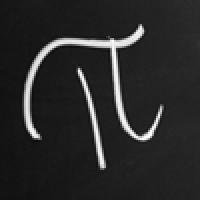
Why the world needs pi
If you had a sloppy maths teacher at school you might have grown up with the idea that the number $\pi$ is equal to $22/7.$ Now that is completely wrong. Writing those numbers out in decimal gives
$22/7 = 3.142...$ while $\pi = 3.141...$. There's a difference in the third decimal place after the decimal point!


How accurately do we need to know the value of π?
Surely this small inaccuracy doesn't matter? Well, as the following extract from a longer article by Chris Budd shows, it really does.
The point is that $\pi$ is not any number. It lies at the heart of any technology that involves rotation or waves, and that is much of mechanical and electrical engineering. If rotating parts in, say, a typical jet engine are not manufactured to high tolerance, then the parts simply won't rotate. This typically involves measurements correct to one part in 10,000 and, as these measurements involve $\pi$, we require a value of $\pi$ to at least this order of accuracy to prevent errors. In medical imaging using CAT or MRI scanners, the scanning devices move on a ring which has to be manufactured to a tolerance of one part in 1,000,000, requiring an even more precise value of $\pi$. However, even this level of accuracy pales into insignificance when we look at modern electrical devices. In high frequency electronics, with frequencies in the order of 1GHz (typical for mobile phones or GPS applications), electrical engineers require a precision in the value used for $\pi$ in the order of one part in 1,000,000,000,000,000. So, the modern world needs $\pi$ and it needs it accurately!Read more about...
Anonymous
while PI is _NOT_ 22/7... you do need an approximation that's useful from time to time.... so I proffer the following:
take the first 3 odd integers and write each twice: 11 33 55
break in the middle 113 355
divide in the (hopefully) obvious way: 355/113 for PI
that should be sufficiently accurate to within a foot/30cm/1 light nanosecond or so on the circumference of the earth
for a practical example, consider this: US Hat sizes are the diameter in 1/8ths of an inch.... all other hat sizes are circumferences in cms.... so what is the conversion factor.... I introduce a second approximation.... take the first two odd numbers and write each the number of times equal to the number...... so 1 333 split in the middle to get 13 inches = 33 cm
so the conversion factor for hat sizes is 355/113 * 33/13 or 11715 / 1469 or 7.97.....
so..... that's why we use 1/8th of an inch..... divide cms by 8 to get the US hat size diameter in inches (measured in 1/8ths).... and you can do it in your head... right there in the store :)
Anonymous
Out of admiration for its importance I memorized it to 100 decimal positions, and think that the most important equation in math is e**i(Pi)=-1 - But BTW I'm an EE so I had it every day in my studies.
Anonymous
How about Tau? (http://www.tauday.com/)